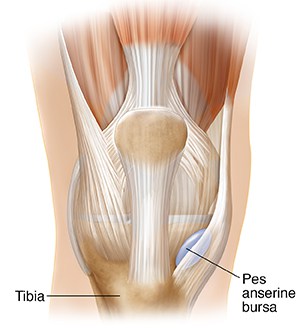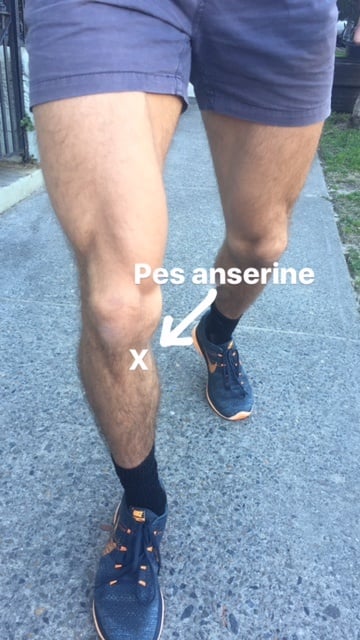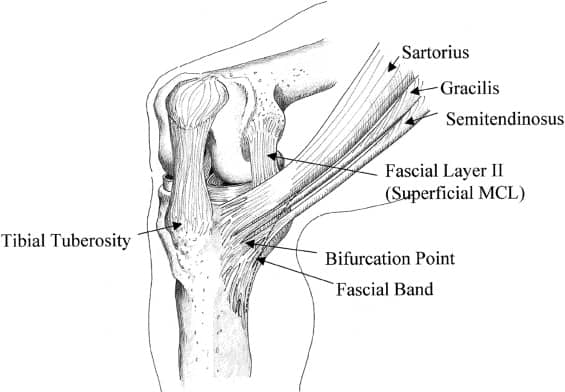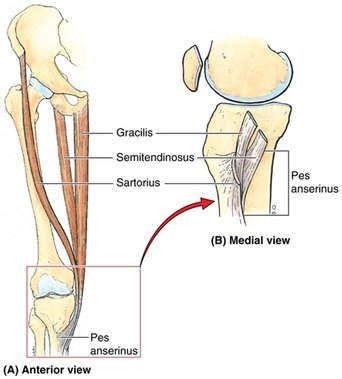
Creating Tibial Space
My relationship with my knee goes in waves of excellence and issue. In periods of calm when things are swell, I enjoy and explore freedoms and push the boundaries of performance. Preferring to walk the unrestricted line of what is possible, there is an inevitably fall back into ‘break’ tides where I become bothered and limited by dysfunctional annoyance. I ride these undulating currents out as naturally as possible, slowing things down and taking the time to pay attention to the intricate connections pieces and parts have on the whole. Studying subtleties in the amplitude of discomfort always lead me back to a clarity of composure.
Anatomy knowledge has never brought the lucidity that feeling movement has, but image searches for this article led me down a tiny rabbit hole of possible causation. The point of irritation lies at an intersection of tendons, under which is a bursa called the Pes Anserine.

What was interesting was that two of the three tendons were involved in my 2006 hamstring graft that replaced a torn ACL — the Semitendinosus (and likely part of the Gracilis).

Though all three muscles flex the knee, they are also internal rotators. Two attach through the back end of the pelvis, and one, the Sartorius, crosses over the front of the quads.

My tibia wasn’t sitting correctly.
It expressed its misuse/misalignment through pain, at particular points of knee flexion.
Anatomical information helps explain the why of movement-based fixes but shouldn’t replace the what or how. Doing a ‘recommended’ motion means nothing unless you can engage with it. The following assistive actions that lessened my pain were found before any landmark investigations were made. The fact that the knee felt best after waking/ rest affirms the ‘let it be’ bursitis protocol. Not aggravating it with too many interrogative pokes and prods was both the best and most difficult part of this process.
1. Separating Tibia from Femur Through the Feet
Pinning the medial ball of foot while driving the knee distally.
Everting the foot (lifting the big toe side and loading the outer edge) in almost any knee/hip position also provided relief. Pointing the toe tended to be more helpful than pulling the toe.
2. Externally Rotating the Tibia
Driving tension outward frees up tissues on the inner ridge.
Putting the hip in external rotation almost always initiates a stretch, and that deep stretch often alleviates tension in the knee (similar to getting a deep stretch in the calf).
3. Pushing the Knee Forward
Separating the femur from the tibia through the hamstring and hip.
My ‘normal’ pattern of motion is the slide, followed by hip/ pelvic rotation. The last method, stabilizing the pelvis and pushing the knee forward through the socket via the hamstrings gave me a new option to play with.
My left foot is often placed forward in squat stance, causing a natural rotation of left hip forward, right hip back. The right bears more weight in this position. An overlooked compensation was a variance in knee height. The left knee sat higher at the bottom of the squat, indicating more hip flexion and and less knee forward. To reverse this pattern, I emphasized knee forward first, and then dropped into a squat.
Feeling through tissue stress was the top priority, not delineating whether the hip was rotating or not.
Lean backs from the tall kneel utilize different pressing down points. Concentrically, it is essentially a knee extension exercise. The knee drives ‘forward’ into the ground along with the shin and ankles, creating a traction gap between the tibia and femur.
Hamstring contractions prime the move to help pull the butt towards heels. The lesser ability of the left is evident here, and a weight shift and rotation into that side helps me more fully feel what is happening there and which variables matter most.
This final sequence combines knee forward with hip external rotation. Starting cross legged with left leg under, I am trying to utilize the hamstring to lengthen the knee. In each I show the contrast between pelvic rotation and stability. The movement with still hips is much more nuanced and minimal, but the internal sensation is miles apart.
The lying figure four employs active hip external rotation which makes the knee press more difficult. The open modified figure for that closes the video examines the influence of hip flexion. The heel slide increases knee flexion, and the hamstring tension is kept throughout hip extension, creating a deeper contraction. Standing up from this move, the knee pinch subsided, and gait became light and easy.
Pinches tend to signify a lack of space. Creating space can happen in a number of different ways, but understanding what you are doing allows you to map out and memorize what works for you in that moment, under those particular circumstances. Momentary fixes applied to larger constructs develop systematic shifts in a positive direction. It, along with learning and becoming more aware, could be the reason we inhabit these bodies in the first place.



